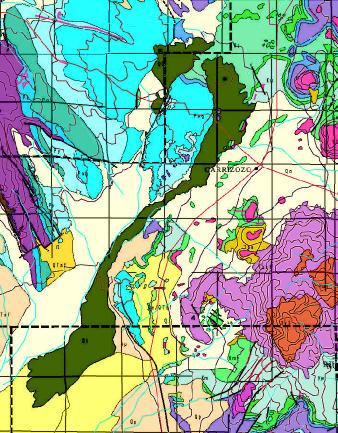
General Geology of the Carrizozo Malpais

The Carrizozo malpais consist of two basaltic lava flows that erupted from within the Tularosa Basin, in south-central New Mexico. A geological map of the Carrizozo Malpais and associated areas is show below. The vent area for the lava flows, Little Black Peak, falls on the Capitan lineament, a zone of crustal weakness that extends across eastern New Mexico. The Capitan lineament is defined by a number of igneous features, including the Capitan Pluton, the Carrizozo lava flow, Broken Back Crater and associated lava flow (seen in dark green color, just to the NW of the main Carrizozo flows) . The Capitan lineament is interpreted as a deeply penetrating zone of crustal weakness along which magmas have been able to rise and erupt (Chapin et al., 1978).
The total eruptive volume of the Carrizozo lava flows is estimated to be 2.8 to 4.3 km3 (Allen, 1952); thickness averages 10-15 m, and the total length of the flow field is 75 km (Keszthelyi and Pieri, 1993). The flows are interpreted as tube-fed (Keszthelyi and Pieri, 1993), and are characterized by pahoehoe textures, such as ropey flow tops, smooth lava sheets, toes, tumuli, and pressure ridges. The flow top of the lava is very well-preserved, and in some places even retains an iridescent appearance, typical of young lava flows. Two distinct lava flows have been identified in the Carrizozo field (Renault, 1970). The lower flow is extends for the full 75 km length. The central part of the flow is narrow, whereas the lower part spreads to a width of nearly 8 km. The upper flow extends approximately 25 km from the vent, is wider, on average, than the lower flow and, where both flows can be observed, is typically thicker (Weber, 1964). The contact between the upper and lower flows is brecciated, but shows no evidence of erosion or soil development (Faris, 1980), suggesting that the time between eruption of the two flows was relatively short.


